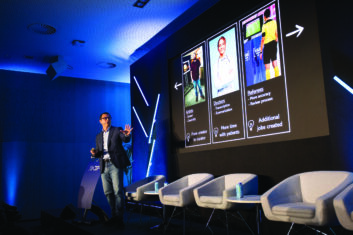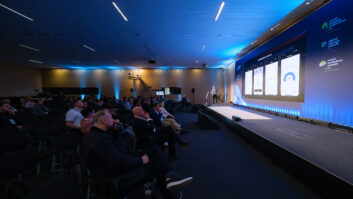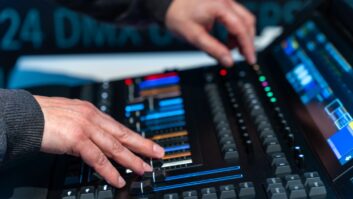
Artificial intelligence (AI) is one of the major talking points of ISE 2024, both in the content programme and on the show floor. On a residential level, according to CEDIA, AI is poised to redefine the way we interact with and experience our homes, making them more intelligent, responsive, and personalised.
CEDIA has hosted 60 hours of professional development courses within its Smart Home Technology Conference that ran from Tuesday to Thursday this week in the CC1 conference suite, as well as in the free-to-attend content programme on the Smart Home Technology Stage.
The association anticipates AI-driven smart home systems becoming increasingly adept at understanding user preferences, learning daily routines, and proactively adjusting settings to optimise comfort, energy efficiency, and security. As AI continues to evolve, the smart home sector stands to benefit from increased automation, improved energy management, and a more intuitive and user-friendly experience, ultimately shaping the future of connected living spaces.
Panel discussions this week have ranged from AI and the Smart Home: Where are we and how might AI shift the dial for home integration in, to Navigating AI Threats in the A/V Industry (both on the Smart Home Technology Stage), where CEDIA’s Giles Sutton was joined by Rich Green, Rich Green Design and Jeff Sonnleitner of Moraine Park Technical College to share insight on how to mitigate audio and video systems from digital threats.
Sonnleitner also provided a deep dive on AI Threats and Cybersecurity for Smart Home Integrators at the Smart Home Technology Conference on Tuesday, which was followed by Giles Sutton and Alex Capecelatro, founder and CEO of Josh.ai, looking at How AI Language Tools Can Revolutionize Workflows for Technology Integrators.
Speaking at his Smart Home Technology Conference session, entitled ‘Future Technologies: The Inside Scoop from Silicon Valley’, on Tuesday, Rich Green suggested that AI is “the last step change in human evolution… by the end of the decade businesses will have no choice but to leverage AI” as computers will reach singularity – an explosion of super intelligence – sooner than we think.
AT AVIXA Xchange LIVE on Tuesday, the Ask The Experts session ‘AI Creative Ownership: Who owns the content AI creates?’ saw panellists Andreea Timis from The LED Studios, Jessica Cooper of Pixel Artworks, and Anna Bulakh from Respeecher, discussed AI-generated content, what you need to create it, and what it means for content creators.
The panel came to the verdict that AI is set to have a huge impact on the creative process, adding new levels of creativity for content producers as well as speeding up production processes. “Over the last year AI has had a profound impact on digital art; adding a new level of creativity to what we can do,” said Timis. “But the main value for us is more to do with production processes, helping save time in driving the right content to the right displays – which can take a lot of time and cost a lot of money if done manually.”
Wednesday saw a Fireside Chat exploring Is AI Biased? Chris Hope, The Looplab; Stacia Pfeiffer, Pixmodo; Gill Ferrell, 1EdTech and EUNIS; and Jessica Sanders, Absen, pored over concerns around bias in automated systems.
Switch report unveiled at ISE 2024
Tuesday also saw the Catalan Audiovisual Cluster introduce its new Switch report examining the impact of artificial intelligence on AV during a presentation on the ISE Partner Stage today from 15:30 to 16:10.
The presentation featured contributions from report author Joan Rosés, who is editor of the publication Collateral Bits, and Albert Cañigueral, consultant at the Barcelona Supercomputing Center.
Rosés gave an overview of the latest trends for text generation, text to image, and image to video generation, with some eye-catching examples of the use of AI in creating avatars and synthetic voices. He also showed examples of ‘synthetic hyperrealism’ or ‘deep fakes’, as well as completely AI-generated content in the media industry.
“Artificial intelligence is starting to be used as a common resource for many tasks in production, post-production, visual effects creation and virtual production,” said Rosés. “We’ll spend less time on writing and composing soundtracks, and more time in pre-production and less on post-production. We will also see the creation of new jobs.”
Cañigueral suggested that it’s crucial to reimagine work processes in the light of AI’s potential. “What is the society that we want to build with the tools?” he asked. “Instead of asking ‘will AI take my job?’, the question should be, ‘what are we going to do to guarantee that AI deployment [leads to] social and economic progress?’”
The Switch Report is available to download at www.clusteraudiovisual.cat/en/switch-observatory
The dawn of a new era in AI and spatial computing
As we journey through 2024, the realms of generative AI and spatial computing are not just evolving, they are converging to redefine our digital interactions and experiences. That’s according to Yanna Zhu, venture architect immersive and emerging technologies specialist, BCG, who tells the daily that last year was pivotal for AI, with innovations like ChatGPT, Midjourney and DALL-E making headlines. “Simultaneously, advances in XR hardware with HTC’s Vive XR Elite, Meta’s Quest 3 and Apple’s highly anticipated introduction of the Vision Pro offer us more capable spatial computing devices which increasingly blend our physical environment with virtual content,” she said. “These recent developments indicate a future where AI and spatial computing are deeply intertwined, in that spatial computing devices are becoming an interface for AI-powered content.”
The most exciting aspect of this fusion, Zhu explained, lies in the democratisation of content creation, giving virtually anyone the ability to become a creator, regardless of their technical knowledge. “New tools and devices truly break down the barriers that once reserved innovation for those with specialised skills or technical knowledge. With generative AI, intricate and complex ideas can be transformed into tangible digital creations through intuitive interfaces, making sophisticated design, animation and virtual experiences accessible to a broader audience. Spatial computing devices then allow users to interact with and shape their digital environments in a more natural, three-dimensional and human-centric manner. This democratisation not only fosters a rich diversity of perspectives and ideas but also heralds a new era of inclusive innovation, igniting a global renaissance of digital artistry and invention.”
On the show floor, the prevalence of AI within AV applications is clear to see. Examples include Zoom releasing a new generative AI assistant (AI Companion) to its collaboration platform; Crestron’s new 1 Beyond PTZ cameras coming with built-in Visual AI to frame in-room meeting participants; and WolfVision’s Cynap Videobar which combines BYOD wireless presentation technology with a 4K AI camera and beamforming array microphone.
Scott Norder, chief operating officer, RGB Spectrum, told the Daily, “AI is revolutionising the industry in various ways. Within our main focus of video processing solutions, it enhances content creation and consumption. AI’s integration into video processing within the AV industry has led to more immersive, efficient, and personalised content creation and consumption while also reducing production costs and expanding accessibility, making it a crucial driver of innovation in the field.”
While it’s clear that businesses are moving forward with various applications of AI and that the opportunities appear without limit, it’s just as clear that many questions remain as to the risks, both technical and ethical, that generative automation and machine learning bring, particularly as their capabilities continue to accelerate.







